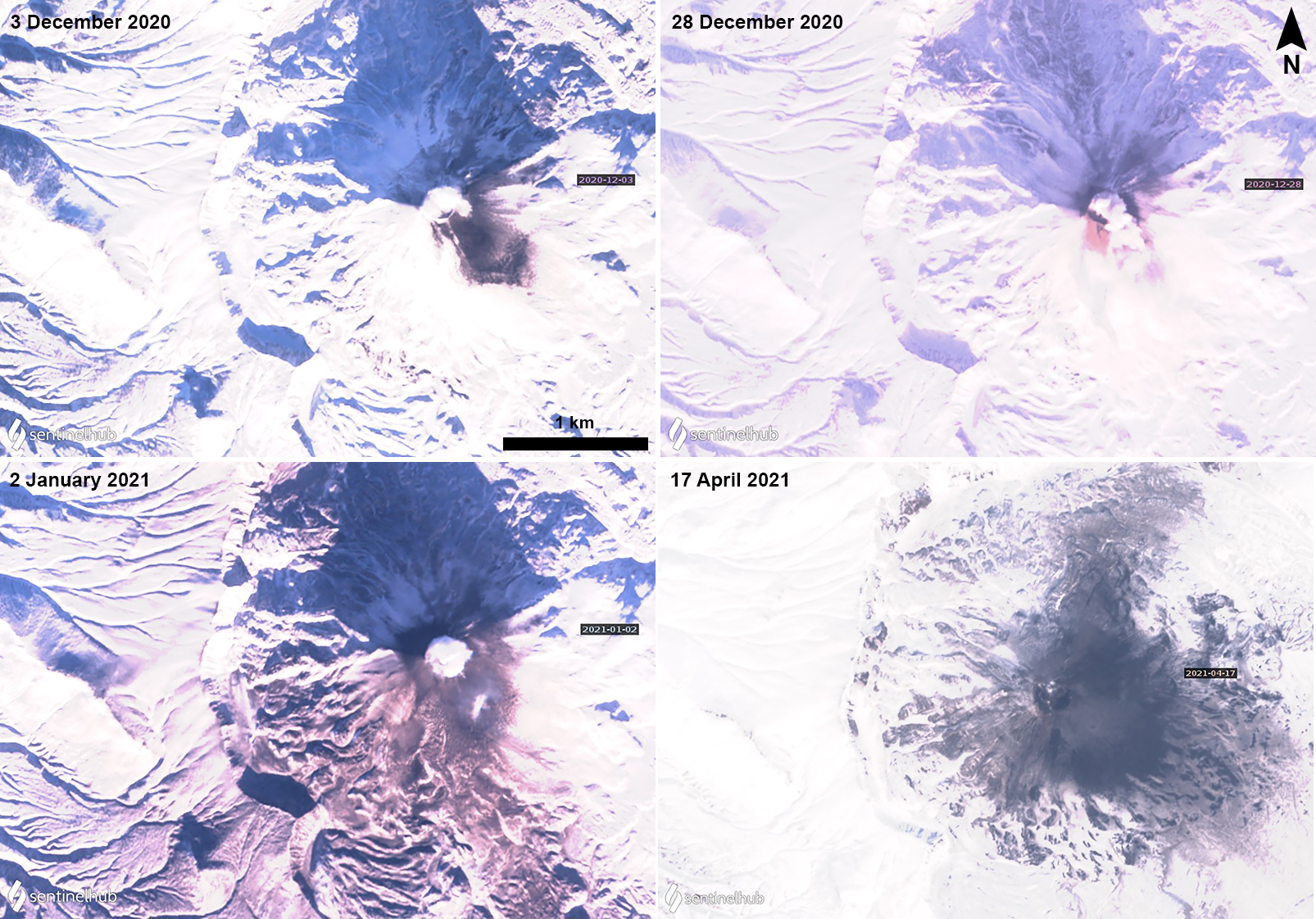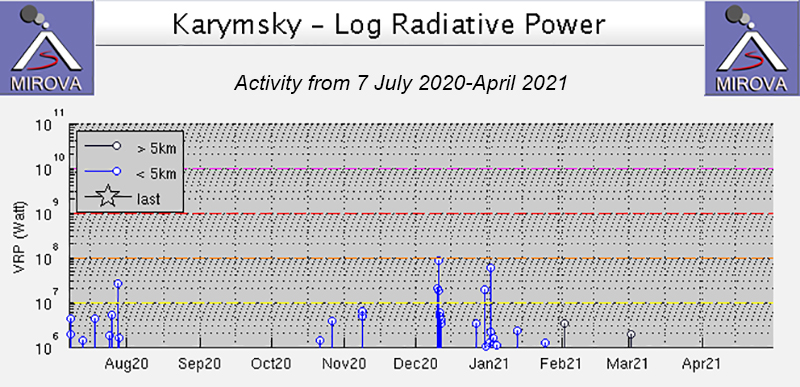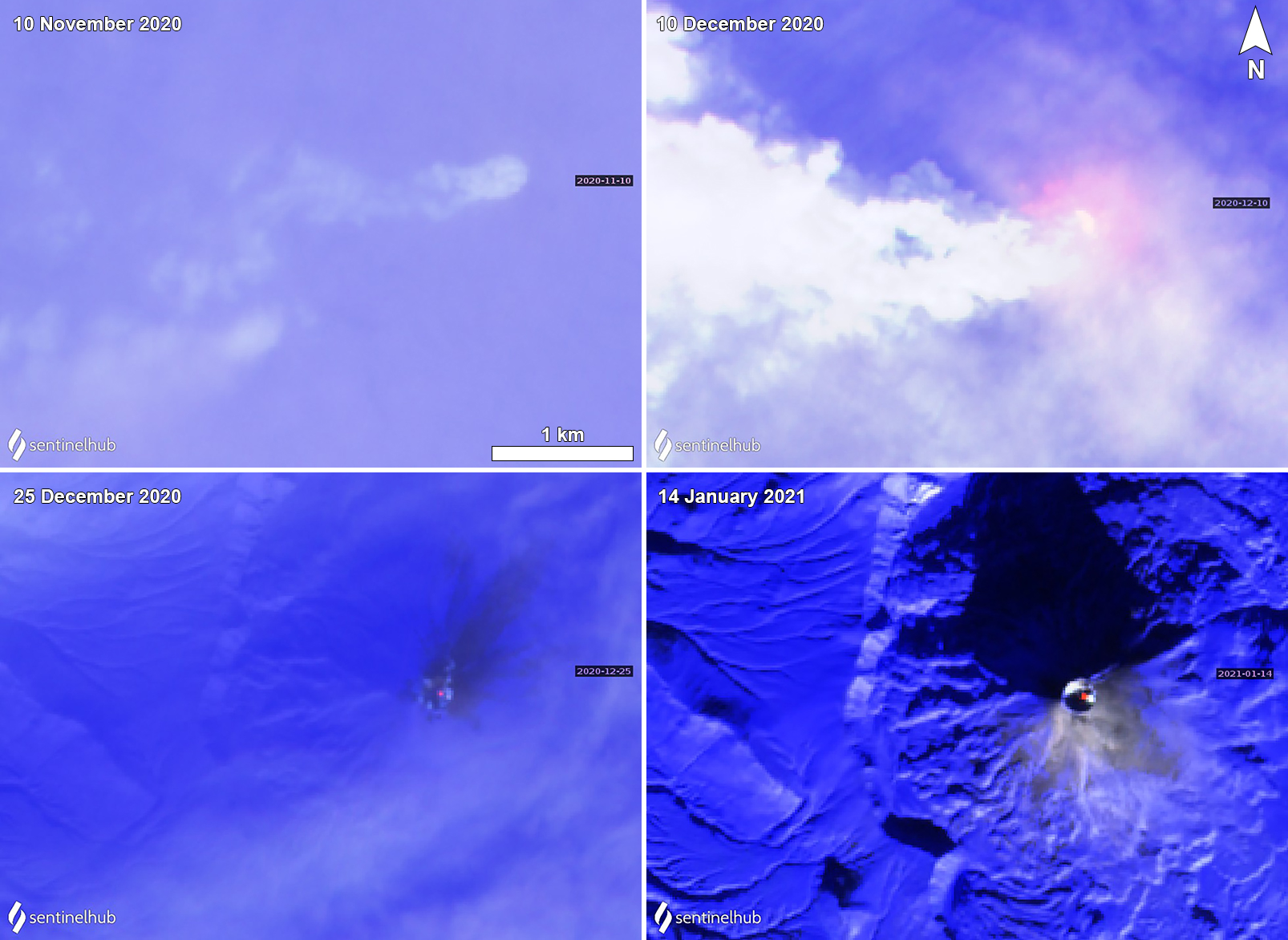Report on Karymsky (Russia) — May 2021
Bulletin of the Global Volcanism Network, vol. 46, no. 5 (May 2021)
Managing Editor: Edward Venzke.
Edited by Kadie L. Bennis.
Karymsky (Russia) Explosions during November 2020-January 2021; new eruptive episode in April 2021
Please cite this report as:
Global Volcanism Program, 2021. Report on Karymsky (Russia) (Bennis, K.L., and Venzke, E., eds.). Bulletin of the Global Volcanism Network, 46:5. Smithsonian Institution. https://doi.org/10.5479/si.GVP.BGVN202105-300130
Karymsky
Russia
54.049°N, 159.443°E; summit elev. 1513 m
All times are local (unless otherwise noted)
Karymsky, part of Kamchatka’s eastern volcanic zone, has had frequent eruptions since 1996 that have included ash explosions, ash plumes, gas-and-steam emissions, and thermal anomalies. Its most recent eruption began in April 2020 and has been characterized by ash explosions, ash plumes, ashfall, gas-and-steam emissions, and thermal anomalies (BGVN 45:10). This report covers activity from November 2020 through April 2021 and describes the start of a new eruption in April. Information comes from daily, weekly, and special reports from the Kamchatka Volcanic Eruptions Response Team (KVERT), the Tokyo Volcanic Ash Advisory Center (VAAC), and satellite data.
During the first half of November 2020 activity consisted of intermittent explosions accompanied by thermal anomalies. During 1-2 November an explosion sent ash plume to 6.5 km altitude that extended as far as 60 km ENE and 30 km SW. An ash explosion on 8 November generated an ash plume that rose to 8 km altitude and drifted 230 km NE. According to the Tokyo VAAC ash plumes were observed on 9 and 11 November that rose to 6 and 7 km, respectively. Intermittent thermal anomalies were observed in satellite data throughout the month.
Moderate gas-and-steam emissions were observed intermittently during December, sometimes accompanied by thermal anomalies. On 10 December, at 0845 local time, explosions generated ash plumes that rose to 6-7 km altitude and drifted NW. Ash explosions continued throughout the day, drifting as far as 220 km NW, W, and SW. Subsequent ash plumes were reported on 13 and 18 December that rose to 3.9 km altitude and drifted N, and 2.7 km altitude that drifted SW, respectively. Explosions on 26 and 30 December produced ash plumes that rose to 4-5 km altitude and drifted as far as 70 km NW. The Tokyo VAAC reported ash plumes to 5.2 km altitude that drifted NW and N on 27 December, to 3 km altitude that drifted SE on 29 December, and to 4.6 km altitude that drifted W on 31 December.
Similar ash explosions accompanied by thermal anomalies were reported during early January 2021. On 1 January the Tokyo VAAC reported an ash plume that rose up to 5.2 km altitude and drifted S, followed the next day by explosions that sent plumes to 5.5 km altitude and drifted 130 km SE. Some of the resulting ash deposits on the snow-covered flanks were observed in Sentinel-2 natural color satellite imagery (figure 55). KVERT reported that a thermal anomaly over a lava dome was visible in satellite images during 14-15, 20-24, and 27 January. Explosivity significantly decreased in February and activity was primarily characterized by moderate gas-and-steam emissions and a thermal anomaly that was last detected on 5 February.
During 2-6 April a thermal anomaly was detected in satellite data, according to KVERT. Explosions on 4 April at 1130 local time resulted in ash plumes that rose to 8.5 km altitude, which then drifted NE for 255 km during the day, marking the beginning of a new eruptive episode. On 11 April at 1745 ash explosions rose to 4 km altitude and drifted 67-115 km SE, according to a VONA (Volcano Observatory Notice for Aviation). KVERT continued to report weak thermal anomalies that were visible in satellite images during 9-12, 16-17, 22-23, and 29 April.
MIROVA (Middle InfraRed Observation of Volcanic Activity) analysis of MODIS satellite data shows three small clusters of low-to-moderate strength thermal anomalies during early November, early December 2020, and early January 2021 (figure 56), which each coincided with explosion events reported by KVERT. No thermal activity was detected after late January through April, according to the MIROVA graph, though KVERT noted thermal anomalies during early February and again in early April. A total of two thermal hotspots were detected by the MODVOLC thermal algorithm on 10 December, which was also visible in an infrared satellite image. Sentinel-2 infrared satellite images captured white gas-and-steam plumes rising from the summit during 10 November and 10 December; on 10 December the explosive events were accompanied by a strong thermal anomaly that was visible through the clouds (figure 57). Weaker thermal anomalies were observed in the summit crater on clear weather days on 25 December and 14 January 2021, which were also reported by KVERT (figure 57).
Geological Summary. Karymsky, the most active volcano of Kamchatka's eastern volcanic zone, is a symmetrical stratovolcano constructed within a 5-km-wide caldera that formed during the early Holocene. The caldera cuts the south side of the Pleistocene Dvor volcano and is located outside the north margin of the large mid-Pleistocene Polovinka caldera, which contains the smaller Akademia Nauk and Odnoboky calderas. Most seismicity preceding Karymsky eruptions originated beneath Akademia Nauk caldera, located immediately south. The caldera enclosing Karymsky formed about 7600-7700 radiocarbon years ago; construction of the stratovolcano began about 2000 years later. The latest eruptive period began about 500 years ago, following a 2300-year quiescence. Much of the cone is mantled by lava flows less than 200 years old. Historical eruptions have been vulcanian or vulcanian-strombolian with moderate explosive activity and occasional lava flows from the summit crater.
Information Contacts: Kamchatka Volcanic Eruptions Response Team (KVERT), Far Eastern Branch, Russian Academy of Sciences, 9 Piip Blvd., Petropavlovsk-Kamchatsky, 683006, Russia (URL: http://www.kscnet.ru/ivs/kvert/); Tokyo Volcanic Ash Advisory Center (VAAC), 1-3-4 Otemachi, Chiyoda-ku, Tokyo 100-8122, Japan (URL: http://ds.data.jma.go.jp/svd/vaac/data/); MIROVA (Middle InfraRed Observation of Volcanic Activity), a collaborative project between the Universities of Turin and Florence (Italy) supported by the Centre for Volcanic Risk of the Italian Civil Protection Department (URL: http://www.mirovaweb.it/); Hawai'i Institute of Geophysics and Planetology (HIGP) - MODVOLC Thermal Alerts System, School of Ocean and Earth Science and Technology (SOEST), Univ. of Hawai'i, 2525 Correa Road, Honolulu, HI 96822, USA (URL: http://modis.higp.hawaii.edu/); Sentinel Hub Playground (URL: https://www.sentinel-hub.com/explore/sentinel-playground).




